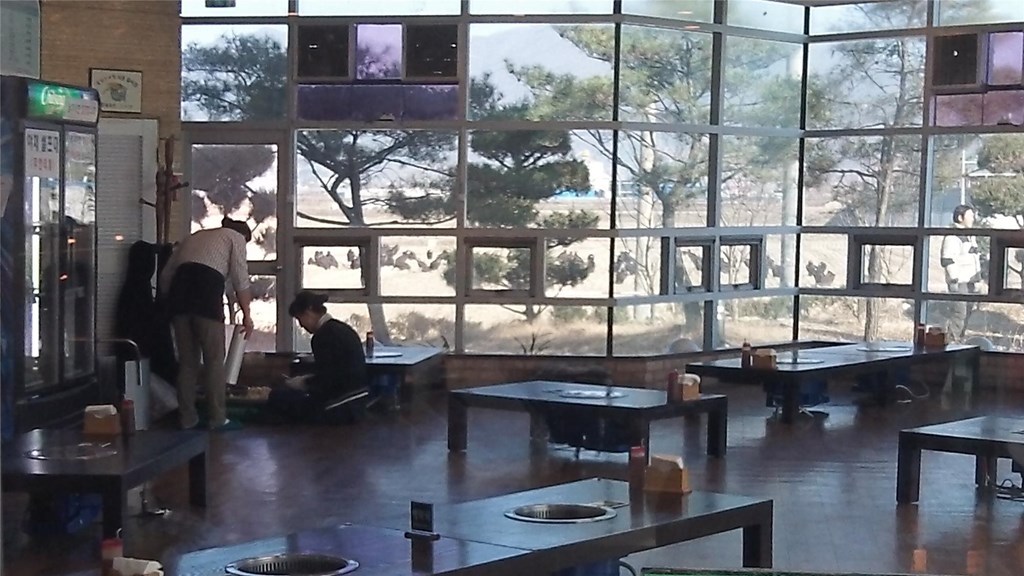Scavengers enjoy "vulture restaurants" in Korea
Posted on January 20, 2011 in Science

Vultures find paradise in Korea
Scavengers enjoy their 'vulture restaurants'
In a recent post on The Vulture Chronicles, Sarkis Acopian Director of Conservation Science Dr. Keith Bildstein blogs about his recent trip to Korea and how the vultures there are fairing (hint: it's good news!).
Text from the blog:
Korea: an overwintering paradise for young Cinereous Vultures
January 20, 2012 by Keith L. Bildstein, Ph.D.
Sarkis Acopian Director of Conservation Science
I am just back from a week in Korea with some good news about vultures.
Juveniles of the largest Old World scavenging bird of prey, the Cinereous Vulture, appear to have found a slice of heaven in South Korea just south of the Korean DMZ, the no-man’s-land that has separated the Koreas since the 1950s. The species, which is considered Neat Threatened globally, has an estimated world population of between 7.5 and 10 thousand breeding pairs, and a distribution that stretches from Spain to China and as far north as Mongolia.
Cinereous Vultures, which are at risk from incidental and targeted persecution by people, as well as by declines in large carrion due to changing agricultural practices, are declining in many parts of their range. One bright spot is Mongolia where breeding populations appear to be expanding.
Although adult Cinereous Vultures that breed in Mongolia overwinter there as well, juveniles and sub-adults retreat to the south and east into China, and, increasingly, into South Korea in winter. The number of individuals overwintering in Korea was quite small in the 1990s, but it is estimated that at least 2,000 do so now, with many ranging over farmlands just south of the DMZ.
I recently saw some of these birds on several field trips associated with the 7th Symposium of the Asian Raptor Research and Conservation Network I attended earlier this month. Within a few kilometers of the rugged mountains of North Korea, these gentle scavenging giants are receiving a helping hand from South Koreans via “vulture restaurants,” places where people provide a “human subsidy” of carrion, offal, and animal fat, for the growing population of juvenile and sub-adult vultures.
Each Cinereous Vulture requires at least a pound food each day to make it through the winter, and by my calculations this means that about a ton of food or more is needed each day to sustain the entire population. The restaurants help significantly.
Some of these “bird feeders,” which usually are located in rice paddies, are run by conservation NGOs, but many others are run by cattle and pig farmers, and butcher shops. The feeding protocol is simple enough. The restauranteurs disperse carcasses and offal across dry rice paddies on a predictable basis, and the birds quickly learn where and when to congregate for the handouts.
The first restaurant I visited, which was less than two kilometers south of the DMZ, required a military escort. The site, on a small hill surrounded by rice paddies, was being used by more than 50 vultures. The food consisted of two adult dairy cows that had died during childbirth and their still-born offspring. The carcasses, which had been delivered to the site the day before we arrived, were now largely skin and bones. Our party arrived in late afternoon, and most of the birds were sitting on the tops of wooden utility poles digesting their meals, while presumably contemplating returning to their evening communal roosts. The second site I visited was even more inspiring.
We arrived at an upscale butchershop/Korean barbeque restaurant near Cheorwan at eleven the next morning. The rice paddies surrounding the shop were dotted with more than 150 hungry vultures. Half an hour later the butcher emerged from the back of the shop, walked into the rice paddy, and tossed 20 to 30 kilos of fat onto the field. The vultures, a bit tentative at first in front of the crowd of more 100 raptor specialists, waited impatiently as we snapped photos of the event. They then converged on the fat.
One of the vultures was wearing a white wing tag with the alpha-numeric “A6,” indicating that it had been tagged as a nestling in central Mongolia thousands of kilometers to the northwest in August 2011. What really made the moment special was that the owner of the shop and barbeque restaurant came out to tell us that he had been feeding the vultures for five years. It was his idea from the start. His was a culture that not only tolerated these enormous 20 to 25 pound birds, but felt obligated to help them as well. That the butcher had erected a sign in his parking lot explaining the situation to his customers, and inviting them to watch the birds, only served make the event more even more poignant.
Working in the Falkland Islands and elsewhere in the New World where many people consider vultures to be “disgusting creatures,” the attitude of this butcher and that of a farmer whose restaurant we visited later in the day was refreshing, as was the wonder I saw in the eyes of several children in the parking lot of the butcher shop whose parents had brought them there to watch the feeding birds.
The people of South Korea are right on target. Protecting and helping Eurasia’s largest scavenging raptor is the right thing to do. Spreading this idea to other cultures is also the right thing to do, and I will begin working on that later this year.
In traveling to the symposium with as little luggage as possible I left my real camera behind in Pennsylvania. The accompanying photo was taken from inside the barbeque restaurant. Note the vultures outside the window in the paddy. Better photos will follow in several days when several former Hawk Mountain interns send me theirs. In the mean time, you may want to visit Wikipedia and Google Images for additional information and photos of this species.